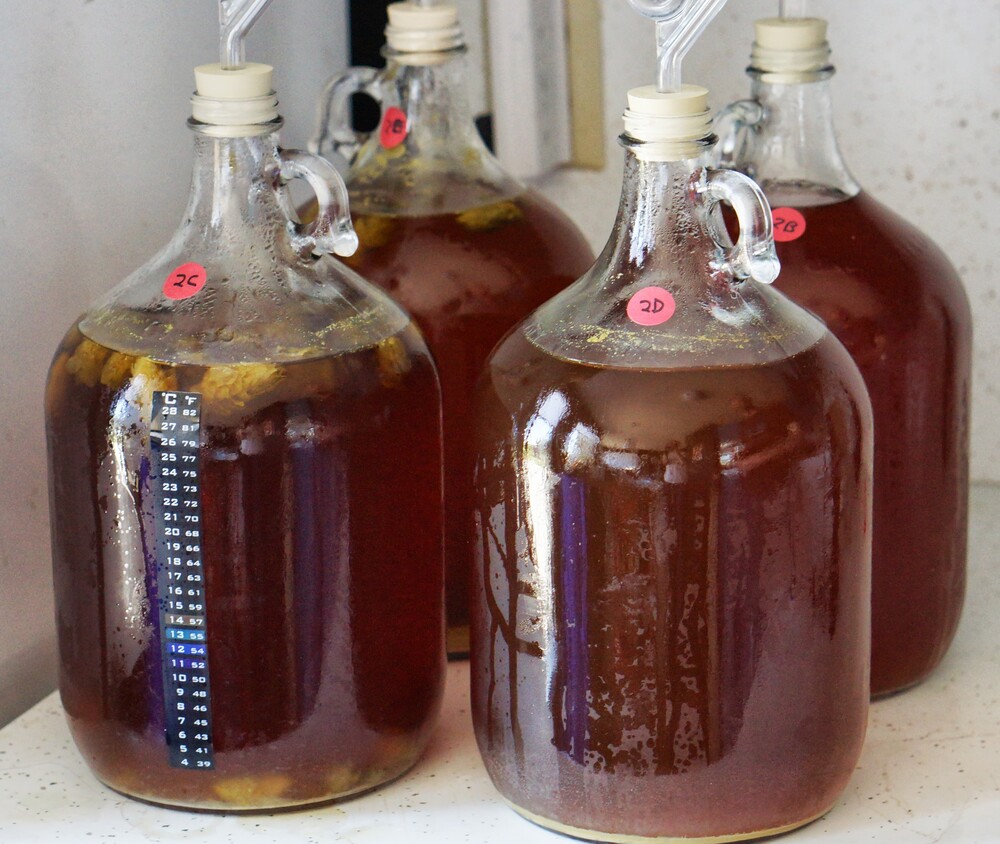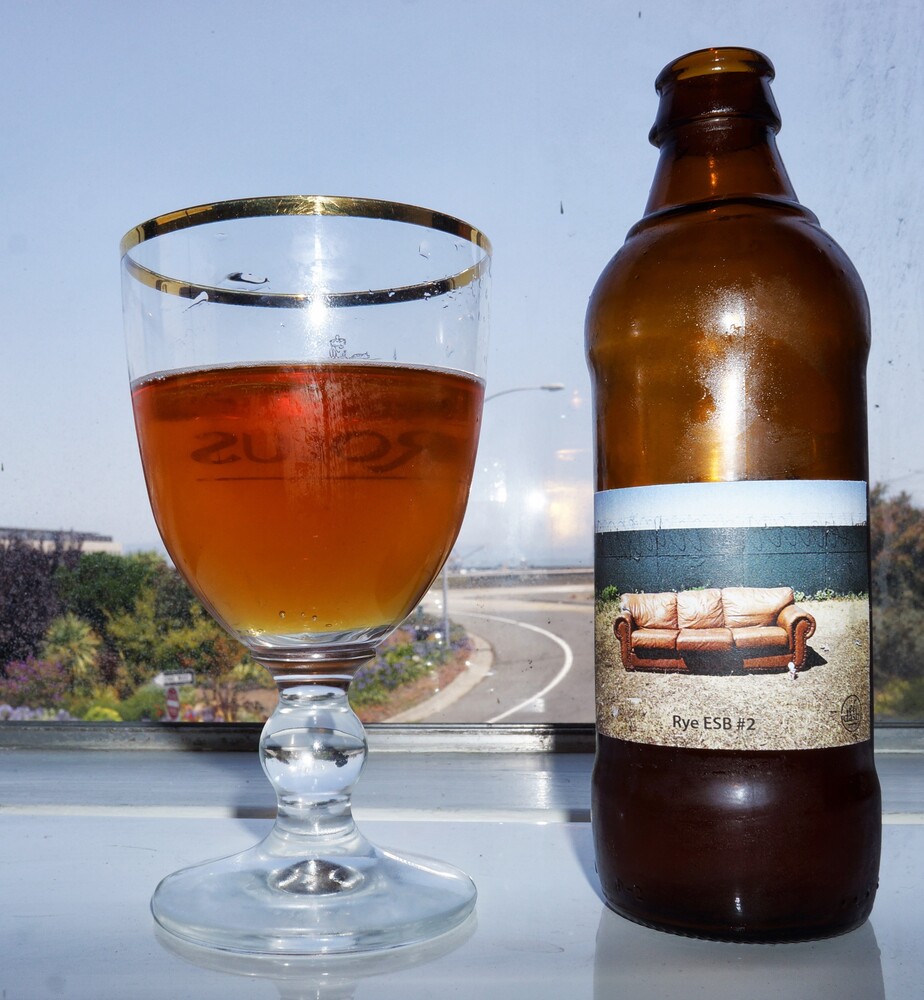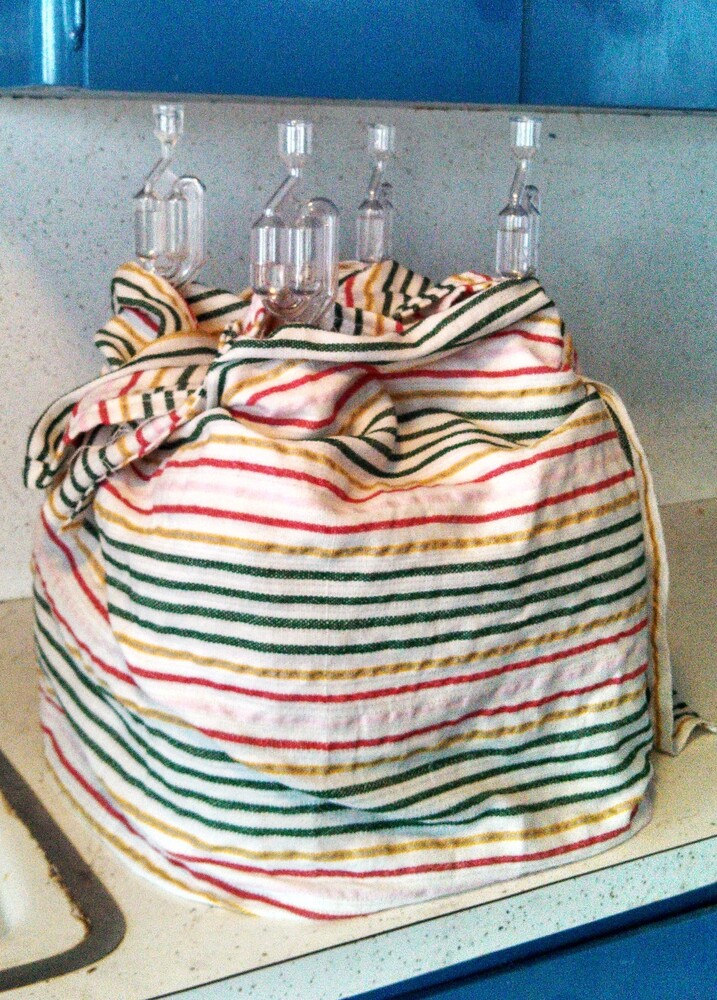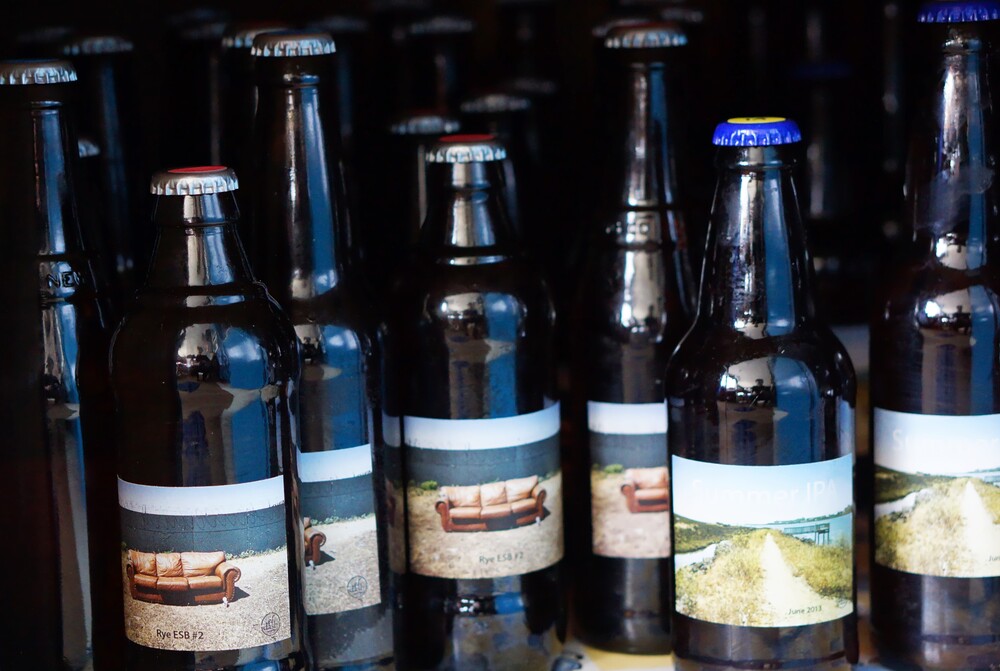Jotting down notes and photos for my second homebrew batch (a mutt which started as a British-style Extra Special Bitter, with the addition of some rye for flavor, then split into multiple 1-gallon batches to try additional experiments).
A note on an ESB (Extra Special Bitter)– it’s a British ale style that’s not actually especially bitter, more similar to a Pale Ale than an IPA. From the BJCP: “An average-strength to moderately-strong [4.6-6.2% ABV] English ale. The balance may be fairly even between malt and hops to somewhat bitter. Drinkability is a critical component of the style; emphasis is still on the bittering hop addition as opposed to the aggressive middle and late hopping seen in American ales. A rather broad style that allows for considerable interpretation by the brewer.”
Mine was 4.9% ABV, 20 IBUs, fermented on the cool end, 1.048 OG, 1.011 FG
Grains:
- 5.5 lbs amber liquid malt extract (the bulk of the fermentables)
- 1.5 lbs 2-row (basic malted barley, adds flavor and provides enzymes to help convert the other grains)
- 0.75 lbs malted rye
- 0.5 lbs 30L crystal
- 0.25 lbs flaked barley
The same “partial mash” process as before: whole grains cracked, added in a cheesecloth sack to 3 gallons of 155F water (Hetch Hetchy reservoir water straight from the SF city tap) then covered and wrapped in a towel to keep at temperature for 50 minutes (it only lost about 3 degrees), before removing the sack of grains (dipping and squeezing it to extract the runnings), raising the pot to 190F, adding the malt extract, and bringing to a boil.
Hops:(British hops for bittering and flavor)
- 1 oz Bramling Cross @60
- 0.5 oz Kent Goldings @15
- 0.5 oz Kent Goldings @5
- Some batches got additional dry hopping later, see below
The usual cooling in a sink of ice water, adding to 3 gallons of cold water to bring the batch up to a bit over 5 gallons, measuring the gravity (1.047), then pitching 11.5g of hydrated (but originally dry) Safale S-04 English Ale Yeast.
As before, I set the fermenter in my cool garage (about 65F ambient), towards the bottom of the recommended yeast temperature, for slower but hopefully lower-ester fermentation. It started fermenting within half a day, and the bubbling tapered off after about three days. I took a gravity sample and it was at 1.014, close to the target, but there was still a noticeable yeast smell/taste. Patience… After about two weeks total, it had been stabilized at a SG of 1.011 for a while and yeast had settled out of suspension.
Tasting at this point– the slightly sweet malt was distinctive, with just a small balanced hint of bitterness. This seems like it’s going in a good direction.
I siphoned off four gallons into four separate one gallon glass jugs as secondaries, each with their own airlock, to try a few different things that could end up terrible or over-the-top:
2B: Control Beer
No changes, no dry hops, just left to condition for a week and a half in this secondary.
2C: Simcoe Dry Hop
0.3oz of Simcoe whole leaf hops, which is equivalent to about 1.5oz of dry hopping in a 5 gallon batch: a modest amount. This hop is counter to the traditional ESB style, more in line with an American West Coast Pale Ale.
2D: Juniper + hint of Sorachi Ace 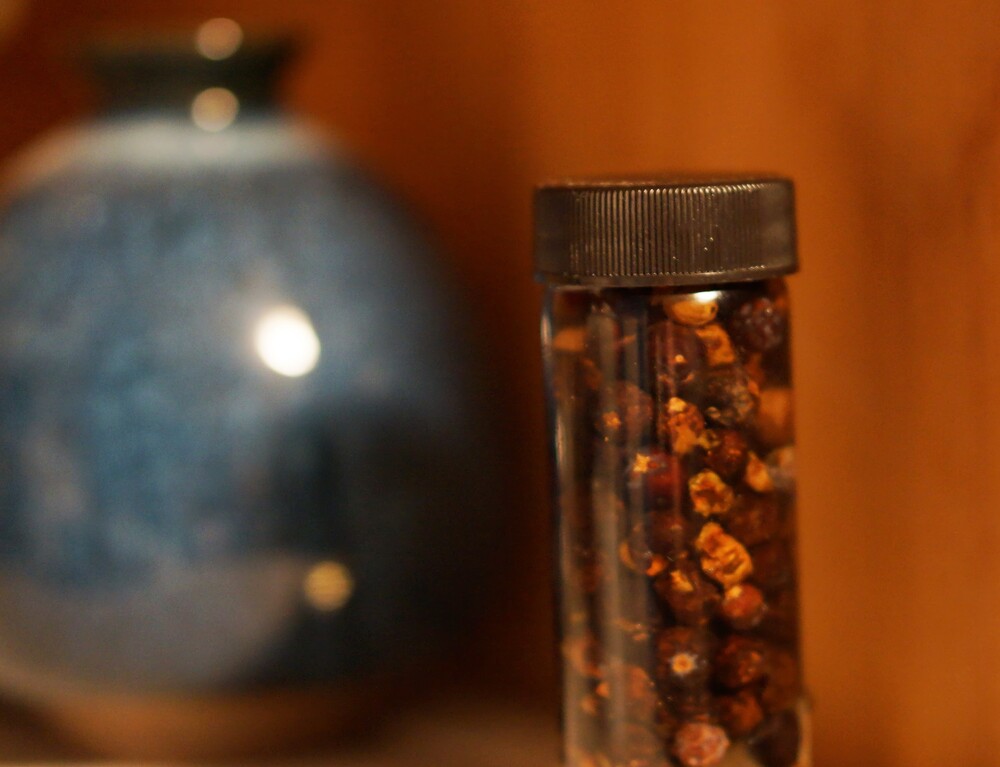
I’ve been curious about the combination of juniper and rye, and had read that 0.5oz of juniper in a 5 gallon batch is noticeable and 1oz is on the edge of too much, though it depends if you boil the berries or add them later. I started by making a juniper infusion: about 1/4oz of crushed juniper berries in 2/3 oz of vodka, let sit for 3 days. It tasted like a very strong (almost undrinkably intense) gin at this point. Then I strained out the berries and added the vodka to this batch of beer, which should be equivalent to about 1oz of juniper per 5 gallons of beer, depending how much of the juniper flavor the vodka leached out.
Then, five days before bottling, I added about 1/20th oz of Sorachi Ace pellets (equivalent to 1/4 oz in a 5 gallon batch), a very mild dry-hopping but hoping for a hint of citrus aroma to go with the juniper.
2E: Hop Bomb
I dry hopped with a lot of high alpha-acid hops, at a level equivalent to 4oz of dry-hopping in a 5-gallon batch. We’ll see if this is even drinkable, but I was inspired by the Linden St “Hop Candi”, which is a mild English-style beer with almost no bittering hops and a huge amount of dry hopping– so you approach it cautiously, expecting a very bitter beer, and then the taste throws you for a loop. We’ll see what this is like.
In particular, I dry-hopped this gallon with 0.25oz each of Centennial and Sorachi Ace pellet hops, and 0.25oz of Simcoe whole hops, for 5 days.
After wrapping all the jugs in a blanket to keep out the sun, I let “the beast with four airlocks” sit, condition, and infuse…
About four weeks after the initial brewday, it was time to bottle, and a group of friends came by to help handle the siphon + bottle filler combination. We got everything bottled, capped (E brought an impressive lever-handle capper, which came in handy for some large 750mL bottles I’d been given at the brewstore), labeled (each variant needed its own label, of course), and into the cupboard to condition and carbonate.
[edit, August 2013 – tasting notes:]
About two weeks after bottling I tried one of the “2B"s (baseline Rye ESB)– it had a nice, clear, amber color, with a malty-sweet smell. The taste was good up front, a mild, restrained, spicy bitterness and some chewy rye flavor. However, the aftertaste was sweet and with a disappointing tart flavor like a granny smith apple that overpowered the malt. Looking online, I saw this “green apple flavor” is a specific defect many homebrewers run in to:
“Acetaldehyde: A flavor of green apples or freshly cut pumpkin; it is an intermediate compound in the formation of alcohol. Some yeast strains produce more than others, but generally it’s presence indicates that the beer is too young and needs more time to condition.”
While this suggests I could have left it in secondary fermentation longer, the good news is there’s still some yeast in the bottled beer (eating the sugar for carbonation), and reading suggests that letting the beer sit in bottles for longer can reduce this flavor.
I turned up the patience knob and waited another three weeks– and there was a real difference– the acetaldehyde flavor was almost completely gone. Now, tasting all five variants (not side-by-side, but over various evenings):
2B (base Rye ESB):
A good though plain beer. It still had a hint of spicy hop and chewy rye up front, then a good malty flavor, but no particular aroma or finish and a little thin and lightly-carbonated, and still a very faint hint of the acetaldehyde. I’d give it a solid B. Not something I’d regret ordering in a bar, but not something I’d order again.
2C (base Rye ESB + light Simcoe dry hop):
This was a solid beer– some mildly skunky (in a good way) hop aroma that brought out some more flavor (and as a side benefit, no detectable acetaldehyde). I already like this better than Full Sail ESB (which I find a bit too sweet). I’d give it a B+.
2D (Rye ESB + juniper + light sorachi ace dry hop):
Very interesting– the juniper taste wasn’t immediately identifiable as such, but there was clearly something different about this beer. It tasted drier, and very slightly tannic/stringent/tongue-drying and citrusy, reminiscent of a gin gimlet. I’ve only had one but would make this again. I give it an A-.
2E (base Rye ESB + heavy dry hopping):
Unusual– as intended, a powerful pine and citrus and funk hop aroma. My brain expected a too-bitter hoppy, bite– but the taste was clean, almost no bitterness or aftertaste. I’m not sure how I feel about it– I’m curious to see what friends think. I could see brewing this again as a “Ghost Hop Bitter”.
2A (small amount of base ESB that had been sitting on yeast cake for a month):
I did this to see if it would produce the off-taste of autolysis (dead yeast, a meaty/earthy/band-aid-y flavor). Some homebrewers claim this is a serious issue and a reason not to keep beer in the primary for more than 1-2 weeks, but many claim that only professional brewers run in to this (due to the weight/pressure/heat commercial-scale brewing puts on the yeast) and that healthy yeast in a 5-gallon homebrewing pail can go a month+ without autolyzing, and there’s no reason to rack beer from primary to secondary and expose it to more risk of oxygen and contamination.
I had to see for myself, and my experience was somewhere in-between– in my first IPA batch (and a later rye batch), I let the beer sit in a primary the entire time of fermenting with no noticeable effect on taste. However, the <1 gallon of this ESB I let sit on yeast for a month and then bottled with a lot of yeast (since I couldn’t filter it out) was heavily cloudy and did have that strong band-aid flavor, bad enough that I poured it out. My preparation of the dry yeast could also have killed some of it up front.
